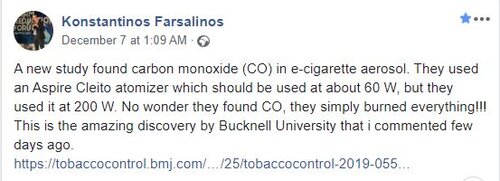https://tobaccocontrol.bmj.com/content/early/2019/11/25/tobaccocontrol-2019-055078
Abstract
"The e-fluid heated in electronic cigarettes (e-cigarettes) is largely composed of organic compounds, specifically propylene glycol, vegetable glycerin and flavouring compounds. When heated, as it is in an e-cigarette, the chemical species in this fluid have the potential to oxidise into carbon monoxide (CO) and other species. Using diode laser spectroscopy, the concentration of CO in e-cigarette mainstream effluent as a function of e-cigarette power and flavour was measured. Carbon monoxide concentration was found to be a direct function of the power of the resistive heating. At the highest powers testable using commercial e-cigarette components, the maximum CO concentration measured was over 180 ppm. The flavouring compounds in the e-fluid also had an effect on the concentration of carbon monoxide present in the effluent."
[And here's what Farsalinos has to say]

Abstract
"The e-fluid heated in electronic cigarettes (e-cigarettes) is largely composed of organic compounds, specifically propylene glycol, vegetable glycerin and flavouring compounds. When heated, as it is in an e-cigarette, the chemical species in this fluid have the potential to oxidise into carbon monoxide (CO) and other species. Using diode laser spectroscopy, the concentration of CO in e-cigarette mainstream effluent as a function of e-cigarette power and flavour was measured. Carbon monoxide concentration was found to be a direct function of the power of the resistive heating. At the highest powers testable using commercial e-cigarette components, the maximum CO concentration measured was over 180 ppm. The flavouring compounds in the e-fluid also had an effect on the concentration of carbon monoxide present in the effluent."
[And here's what Farsalinos has to say]





